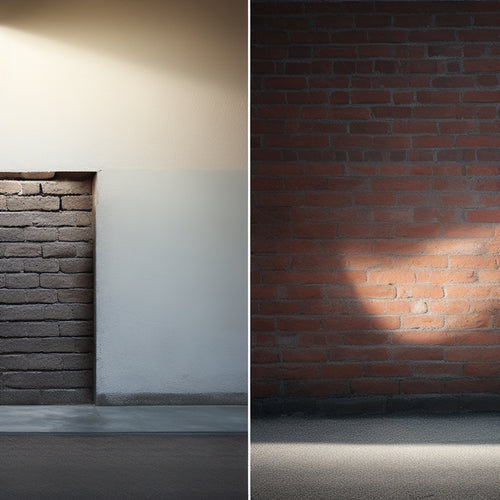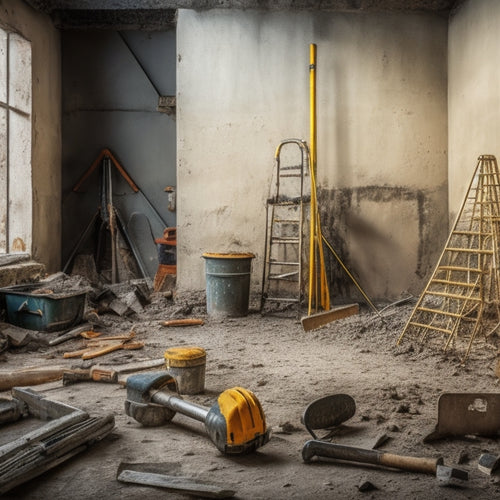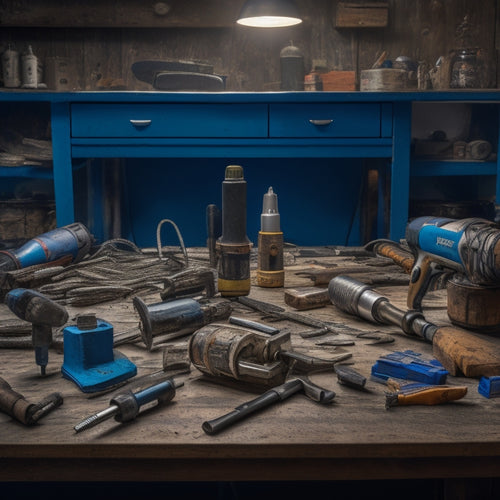
Mixer and Accessories Buying Guide for Home Renovators
Share
When tackling a home renovation project, choosing the right mixer and accessories is crucial for achieving professional-quality results and avoiding costly mistakes. You'll need to evaluate three main types of concrete mixers: electric, gas-powered, and hand-held, each with its own strengths and weaknesses. Electric mixers are ideal for residential projects, while gas-powered ones are better suited for large-scale renovations. Hand-held mixing tools provide precise control and are perfect for small spaces. As you explore your options, think about essential accessories, key features, and your budget. You'll soon discover the perfect combination to get your project off to a great start, and there's more to explore ahead.
Key Takeaways
• Three types of concrete mixers exist: electric, gas-powered, and hand-held, each suited for specific tasks and project scales.
• Essential mixer accessories, such as wire whip and dough hook, enhance mixing efficiency and precision for professional-quality results.
• Key features to consider when buying a mixer include specifications, size, power options, and flexibility to ensure efficient handling of mixing tasks.
• Budgeting for a mixer purchase involves considering brand reputation, usage frequency, and essential features to avoid overspending and prioritize needs.
• Safety precautions and post-purchase maintenance tips, such as regular cleaning and component checks, are crucial for optimal mixer performance and operator safety.
Checklist for Concrete Installation Tools
What tools do you need to get started with concrete installation, and how do you guarantee you've got them all?
Before you begin, take stock of your equipment to verify a smooth and successful project. You'll need a mixer, of course, but don't forget the essentials for concrete preparation techniques.
A sturdy trowel, edger, and float are must-haves for achieving a professional finish. A level, screed board, and bull float will help you achieve the perfect pour.
Don't overlook the importance of mixing consistency – a mixing bucket, measuring cups, and a mixing stick will verify your concrete is mixed to perfection.
A wheelbarrow or mixing tub will make transporting and mixing your concrete a breeze.
Finally, don't forget personal protective equipment like gloves, safety glasses, and a dust mask.
With these tools in your arsenal, you'll be well on your way to mastering concrete installation. Remember, the right tools are just as important as the right mixing consistency – don't compromise on either.
Types of Concrete Mixers Available
When it comes to choosing a concrete mixer, you'll find three main types on the market: electric, gas-powered, and hand-held options.
You'll need to evaluate factors like power, portability, and cost to decide which type is right for your project.
Let's take a closer look at each of these mixer types to determine which one best fits your needs.
Electric Concrete Mixers
You'll often find electric concrete mixers on job sites, as they're a popular choice among contractors and DIYers alike due to their ease of use and low maintenance. These mixers are ideal for small to medium-sized projects, such as renovating a bathroom or building a patio. When it comes to mixer performance, electric concrete mixers are known for their consistent and efficient mixing techniques.
Here are some benefits to take into account:
-
Easy to operate: Electric mixers are simple to use, with minimal setup required.
-
Low maintenance: They require less upkeep compared to gas-powered mixers, with fewer moving parts to replace or repair.
-
Quiet operation: Electric mixers are generally quieter than gas-powered models, making them ideal for residential projects.
- Cost-effective: They're often more affordable than gas-powered mixers, with lower operating costs.
When choosing an electric concrete mixer, think about the size of your project, the type of concrete you'll be mixing, and the power output you need. By selecting the right mixer for your job, you'll be able to achieve ideal mixer performance and get the results you're looking for.
Gas-Powered Mixers Options
If electric concrete mixers don't provide enough power for your larger projects, gas-powered mixers are a robust alternative, offering greater capacity and versatility.
These machines are designed to tackle heavy-duty tasks, making them ideal for large-scale renovations, construction sites, and commercial projects.
When choosing a gas-powered mixer, consider the engine's horsepower, as it directly affects the mixer's performance and efficiency. Look for models with high horsepower ratings, typically above 5 HP, to guarantee you can handle demanding tasks.
Additionally, prioritize gas efficiency to minimize fuel consumption and reduce operating costs. Some gas-powered mixers come with features like idle-down technology, which helps conserve fuel when the mixer isn't in use.
Durability is also vital, as these mixers are often subjected to harsh conditions. Opt for models with heavy-duty frames, robust drums, and sturdy components to guarantee your investment lasts.
Hand-Held Mixing Tools
For smaller mixing tasks or tight spaces, hand-held mixing tools prove invaluable, offering precision and control where larger mixers can't reach. As a home renovator, you'll appreciate the versatility and convenience of hand-held mixers. They're perfect for mixing small batches of concrete, mortar, or drywall compound, and can even be used for mixing small amounts of epoxy or adhesives.
Here are some key benefits of hand-held mixing tools:
-
Precise control: Hand-held mixers allow for precise control over the mixing process, ensuring a consistent mix every time.
-
Compact design: Their compact size makes them ideal for tight spaces, such as mixing small batches in a corner or mixing materials in a confined area.
-
Lightweight: Hand-held mixers are typically lightweight, making them easy to maneuver and reducing fatigue.
- Versatility: They can be used for a variety of mixing tasks, from concrete to drywall compound, and even for mixing small amounts of epoxy or adhesives.
When choosing a hand-held mixer, consider the type of mixing tasks you'll be performing most often and select a mixer that's suitable for those tasks.
With the right hand-held mixer and mixing techniques, you'll be able to tackle even the smallest mixing tasks with ease.
Essential Mixer Accessories Overview
Explore the world of mixer accessories, where a few key additions can elevate your mixing experience and reveal new possibilities in the kitchen.
You'll access the full potential of your mixer and expand your culinary horizons. Mixer attachments, for instance, offer a range of benefits, from increased efficiency to precision control. With the right attachments, you can master essential mixing techniques like whipping, kneading, and aerating.
From pastry dough to meringues, and from whipping cream to beating eggs, the right accessories can make all the difference. You'll be able to tackle complex recipes with confidence and ease.
For example, a wire whip attachment is perfect for incorporating air into mixtures, while a dough hook attachment is ideal for kneading sticky dough. With the right accessories, you'll be able to achieve professional-quality results in no time.
Key Features to Consider Buying
Your mixer's performance hinges on its features, so it's crucial you identify the key ones to evaluate when buying. A thorough mixer brands comparison will show you that each brand excels in specific areas. Before making a purchase, consider the following critical features:
-
Speed settings: Look for a mixer with variable speed control, allowing you to adjust the pace according to your mixing techniques overview. This feature guarantees you can tackle a wide range of recipes with precision.
-
Bowl size and material: Assess the bowl's capacity, material, and ease of cleaning. A stainless steel or glass bowl is ideal for durability and hygiene.
-
Beater attachments: Check if the mixer comes with multiple beater attachments, such as a whisk, dough hook, or flat beater. This versatility will expand your mixing capabilities.
- Ergonomic design: Evaluate the mixer's design, focusing on comfort, balance, and ease of use. A well-designed mixer will reduce fatigue and make your mixing tasks more enjoyable.
Mixer Size and Power Options
Determine the ideal mixer size and power option for your baking needs by evaluating the type of recipes you'll be making and the amount of ingredients you'll be handling. This will help you choose a mixer that can efficiently handle your mixing tasks.
When it comes to mixer capacity evaluations, think about the batch size you typically make. If you're a casual baker, a 3-4 quart mixer might be sufficient. However, if you're planning to make large batches or dense dough, you may need a larger capacity mixer, such as 5-6 quarts.
In addition to mixer capacity, you'll also need to evaluate power source options. Do you prefer a mixer that's powered by a cord or one that's cordless? Corded mixers are generally more powerful and reliable, but cordless mixers offer more flexibility and convenience.
Some mixers also come with variable speed controls, which allow you to adjust the speed to suit the type of ingredients you're mixing. By evaluating these factors, you'll be able to choose a mixer that meets your specific baking needs and preferences.
Budgeting for Your Mixer Purchase
When buying a mixer, you'll need to take into account several cost factors that can impact your wallet.
You'll want to think about the mixer's features, brand, and quality, as well as any additional accessories you might need.
Mixer Cost Factors
By evaluating several key factors, you can tailor your budget to find a mixer that meets your specific needs and preferences.
One of the most significant cost factors is the mixer brand. Well-known brands like KitchenAid and Bosch tend to be more expensive than lesser-known brands. Additionally, the type of mixer you need will impact the cost. For example, a stand mixer will typically be more expensive than a handheld mixer.
Here are some other key cost factors to evaluate:
-
Mixer size and capacity: Larger mixers with higher capacities will generally cost more than smaller ones.
-
Features and attachments: Mixers with additional features like slow-start functionality or multiple speed settings will cost more than basic models.
-
Mixer warranties: Look for mixers with extensive warranties that cover parts and labor for an extended period.
- Additional accessories: Some mixers come with additional accessories like bowls, beaters, or whisks, which can add to the overall cost.
Setting a Budget
You'll need to allocate a specific amount for your mixer purchase, so set a realistic budget based on your needs and what you're willing to spend. Consider your frequency of use, the type of projects you'll be working on, and the features you need. This will help you determine how much you're willing to invest in a mixer.
When budgeting for your mixer purchase, it's important to prioritize your needs over your wants. Identify the must-have features and separate them from the nice-to-have ones. This will help you avoid overspending on features you may not use frequently.
Effective budgeting strategies include setting a price range and sticking to it, looking for discounts and promotions, and considering refurbished or certified pre-owned mixers. You can also take advantage of cost-saving tips like buying last year's model or purchasing a bundle deal that includes accessories.
Safety Precautions for Operators
Your safety is paramount when operating a mixer, as the rotating blades and powerful motor can pose serious hazards if not handled properly. To guarantee a safe and successful renovation project, it's vital to take the necessary precautions to prevent accidents.
Before you start mixing, make sure you're properly trained and familiar with the machine's operations. Operator training is significant to understanding the mixer's capabilities and limitations. Additionally, always wear the necessary safety gear, such as gloves, safety glasses, and a dust mask, to protect yourself from flying debris and dust.
Here are some important safety precautions to keep in mind:
-
Read the manual: Understand the mixer's instructions and guidelines before operating it.
-
Wear safety gear: Protect yourself from flying debris and dust with gloves, safety glasses, and a dust mask.
-
Keep a safe distance: Maintain a safe distance from the mixer while it's in operation to avoid accidents.
- Regularly inspect the mixer: Check the machine for any damage or wear and tear before each use.
Post-Purchase Mixer Maintenance Tips
Proper maintenance is key to extending the lifespan of your mixer and ensuring it continues to perform at its best throughout your renovation projects.
You've invested in a quality mixer; now it's time to protect that investment. Regular mixer cleaning is essential to prevent dust and debris buildup, which can affect performance and lead to premature wear. Create a maintenance schedule to stay on track.
Set reminders to clean your mixer every 1-2 weeks, or after each heavy use. Use a soft-bristled brush or cloth to wipe down the exterior and remove any stubborn material. For more thorough cleaning, refer to your mixer's user manual for specific guidance.
Additionally, check and replace worn or damaged parts, such as beaters or bowls, as needed. Lubricate moving parts according to the manufacturer's instructions to keep your mixer running smoothly.
Frequently Asked Questions
Can I Use a Concrete Mixer for Mixing Other Materials Besides Concrete?
You're wondering if your concrete mixer can handle alternative materials beyond concrete? The answer is yes!
Most mixers are designed with versatility in mind, allowing you to mix a range of materials. From mortar and plaster to fertilizers and even food ingredients, your mixer can be a valuable asset.
Just be sure to clean the drum thoroughly between uses to avoid cross-contamination.
With the right attachments and some creativity, your mixer can tackle a variety of tasks beyond concrete mixing.
How Often Should I Inspect and Replace Mixer Wear Parts?
You've heard the adage 'an ounce of prevention is worth a pound of cure.' This rings especially true for mixer maintenance.
Regularly inspect your mixer's wear parts to prevent costly repairs down the line. Aim to check them every 1-3 months, depending on usage.
Don't wait for signs of wear to replace them - proactive wear part replacement will extend your mixer's lifespan and guarantee peak performance.
Are There Any Eco-Friendly or Sustainable Mixer Options Available?
As you shop for a mixer, you're probably wondering if there are eco-friendly options available.
Yes, you can find mixers made from sustainable materials, such as recycled stainless steel or bamboo.
Look for energy-efficient models with low wattage motors or those that use advanced technology to reduce energy consumption.
Some brands even offer mixers with built-in timers to prevent over-mixing, saving you energy and reducing waste.
Can I Rent a Concrete Mixer Instead of Buying One?
Rethinking rental routes? You're wise to weigh the pros of renting a concrete mixer instead of buying.
Calculate the rental costs and factor in the frequency of use. Plus, consider the convenience of avoiding mixer maintenance altogether.
Rental options often include equipment upkeep, freeing you to focus on your project's progress.
Weigh the costs and benefits to determine if renting is the right recipe for your renovation needs.
Do I Need to Hire a Professional to Assemble My Mixer?
You're wondering if you need to hire a pro to assemble your mixer. Not necessarily!
With the right mixer assembly tips and DIY mixer instructions, you can tackle the job yourself. Take your time, follow the manufacturer's guide, and don't be afraid to YouTube any tricky parts. You got this!
Just remember to prioritize safety and guarantee all parts are securely attached before using your new mixer.
Conclusion
As you wrap up your mixer and accessories shopping spree, remember: 'measure twice, cut once.'
Don't rush into a purchase without considering your specific needs and budget.
With the right tools and a bit of planning, you'll be mixing like a pro in no time.
Before you know it, your renovation project will be a masterpiece, and you'll be enjoying the fruits of your labor.
Now, get mixing and make your renovation dreams a reality!
Related Posts
-

Why Use Concrete Blocks in Home Renovation
You're considering using concrete blocks in your home renovation, and for good reason: they offer a unique combinatio...
-

What Tools to Rent for Block Wall Renovation
When renovating a block wall, it's vital to have the right tools for the job. You'll need demolition tools like pry b...
-

What to Look for in Pneumatic Renovation Tools
When selecting pneumatic renovation tools, you'll want to take into account several key factors to guarantee optimal ...


